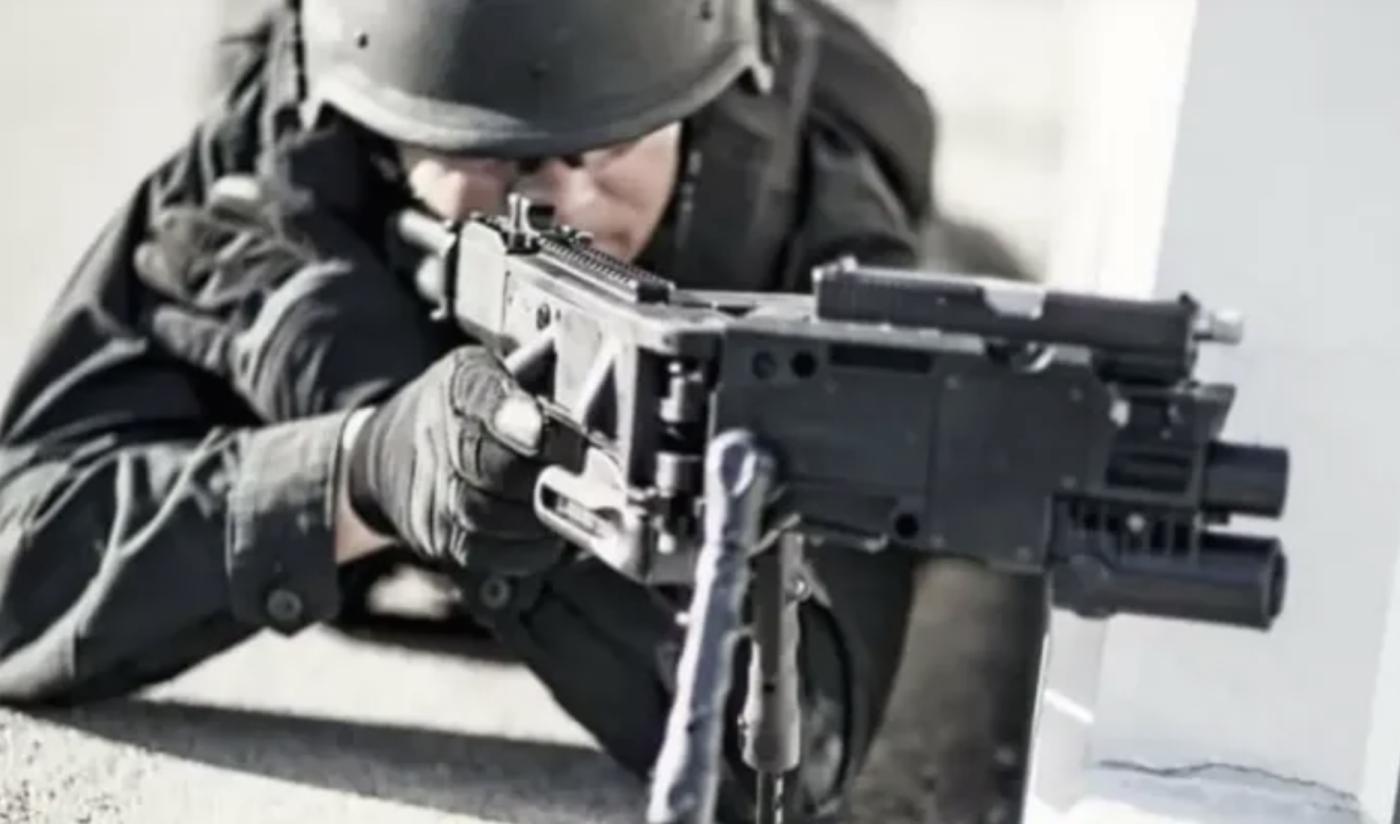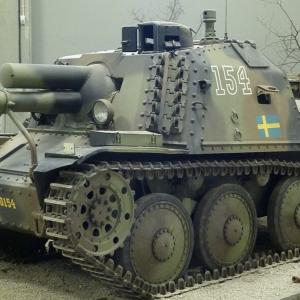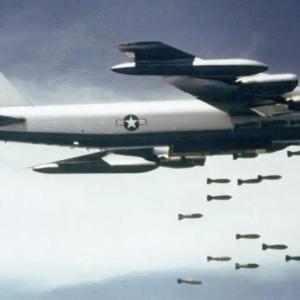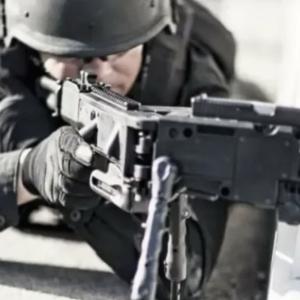
Corner shot Rifle
The CornerShot is a purpose-built accessory that lets an operator observe and fire a handgun or small launcher from behind cover, allowing engagement of a threat around an obstacle without exposing the shooter’s body. At its heart it is a hinged two-part frame: the forward module accepts a pistol (or other small arm), houses a forward-facing camera and illumination and often an aiming laser, while the rear module contains the stock, the user controls, a small video display and the trigger interface. The front can be rotated left or right by tens of degrees so the muzzle and camera point around corners while the shooter remains behind protection and watches the scene on the display, not through direct line-of-sight.
The idea originated from the practical problem faced in urban close-quarters battle and hostage-rescue operations: how to see and, if necessary, apply force into an area without exposing the operator to return fire or observation. Early designs married a quick-detach pistol cradle and a robust hinge with a compact video system so units could use their existing service pistols rather than buying a dedicated new weapon. That modularity remains a key characteristic: the CornerShot frame is essentially calibre-agnostic because it carries whatever pistol is fitted into its cradle, so the ballistic and terminal effects are those of the mounted firearm.
Common pistol calibres supported in production configurations include 9×19mm Parabellum, .40 S&W and .45 ACP, and some variants accept 5.7×28mm pistols. A heavier Assault Pistol Rifle (APR) configuration was developed to accommodate 5.56×45mm rifle cartridges for users who want increased range and terminal performance. In addition to lethal small-arms ammunition, some modules are configured to mount a 40 mm less-lethal or grenade launcher, or to fire specialized less-lethal projectiles for policing tasks. Because the CornerShot carries the pistol, it is compatible with the full spectrum of ammunition types the pistol is designed to use: full-metal-jacket ball rounds for military customers, hollow-point or expanding projectiles for many law-enforcement units that wish to limit over-penetration, and specialty rounds where local doctrine requires them.
Mechanically the system must balance ruggedness with smooth, repeatable aiming. The hinge needs to be stiff and durable yet allow controlled rotation; the trigger linkage must reliably actuate the pistol while preserving safety; the camera and optics must be usable under low light and the electronics must be robust enough for field conditions. Those engineering tradeoffs drive differences between manufacturers and variants: some designs favour simple mechanical reliability and low cost, others pack advanced sensor suites, night vision and video networking.
Tactically, the CornerShot’s value is twofold. First, it reduces the shooter’s exposure during observation and engagement by keeping the operator’s body behind cover. Second, because it includes a forward-facing camera, it functions as a remote reconnaissance tool: teams can inspect a room or corridor, record imagery for after-action review or legal record, and share live video with commanders or adjacent units. These capabilities make it attractive for hostage rescue, high-risk warrant service, counterterrorism raids and any situation where the threat is uncertain and the risk to the first entrant is high.
There are practical drawbacks that keep the platform niche rather than universal. The assembly is heavier and more cumbersome than a bare pistol, it alters target-acquisition psychology because the shooter aims via a screen, it adds electronic and mechanical failure points that must be maintained, and it requires dedicated training to use effectively under stress. In very rapid dynamic entries many units prefer traditional movement and clearing techniques because those methods can be faster and less technically burdensome. For these reasons many organizations treat the CornerShot as a specialist tool for particular scenarios rather than a general replacement for close-quarters tactics.
The concept spread quickly and inspired licensed products, clones and national variants. The original commercial product was developed and marketed internationally, and a number of countries and manufacturers have produced CornerShot-style devices or tested the concept. Publicly reported adopters and developers include police and special units in a range of countries: units in the Middle East and Europe, several Asian states that exhibited or trialed indigenous models, and a number of national law-enforcement agencies that purchased or evaluated the system. Notable patterns include a cluster of locally produced clones in some countries that prioritized low-cost cameras and simple hinges, national variants designed to fit domestic sidearms in others, and a mixture of full procurements and limited trials in still others. Across reporting and trade-show activity, roughly a dozen to twenty countries have either purchased, licensed or locally developed corner-firing systems, though exact counts vary depending on whether prototypes and informal clones are included.
Operationally, calibre selection reflects mission tradeoffs. Nine-millimetre pistols are common because the round is widely available, produces manageable recoil for the hinged mount and fits policing logistics. .40 S&W and .45 ACP offer greater close-range stopping power at the expense of more recoil and bulk. The 5.7×28mm option and the 5.56 mm APR variant push the concept toward higher velocity, flatter trajectory or improved penetration against light protection, but they also change ammunition supply and handling requirements. Less-lethal options make the platform attractive to law-enforcement units that need a way to deliver non-lethal effect while minimizing officer exposure.
Beyond the technical and procurement story, there are a number of interesting practical and doctrinal observations. First, the inclusion of a camera transforms the device from a pure weapons accessory into an intelligence and evidentiary tool, which has influenced police interest because recorded footage can serve training and legal review needs. Second, the rapid appearance of low-cost clones shows how a clear operational advantage is often democratized quickly: when a straightforward mechanical and electronic idea proves useful, it is frequently reproduced in a range of quality and capability levels to meet different budgets. Third, adoption tends to be cautious and mission-specific; units that value speed and simplicity may decline to adopt it, while teams that must mitigate risk to entry personnel often accept the extra complexity.
In short, the CornerShot family of systems addresses a specific, recurring tactical problem by combining remote observation and the ability to immediately apply force while the shooter stays behind cover. It supports a variety of pistol calibres and, in dedicated variants, rifle cartridges and less-lethal launchers. Manufactured in several forms and copied or adapted by multiple countries, it sits today as a specialist instrument in the close-quarters toolkit: highly useful in the right circumstances, but not a wholesale replacement for training, team tactics and established clearing procedures.










